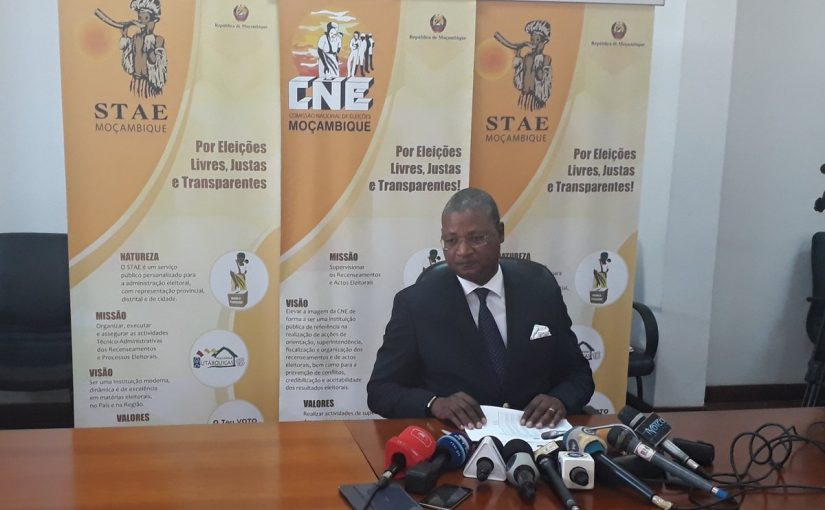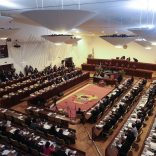Mozambique: President Chapo begins working visit to Inhambane province
CNE approves voter registration results by 11 votes to 5, no abstentions – AIM report

Photo: @CIP_Eleicoes
Mozambique’s National Elections Commission (CNE) on Sunday approved the results of the recent voter registration by 11 votes to five with no abstentions.
Announcing this figure at a Monday press conference in Maputo, the CNE spokesperson, Paulo Cuinica, did not say who voted which way – but given the composition of the CNE it is all but certain that the five members who were appointed by the opposition parties (four by Renamo and one by the Mozambique Democratic Movement, MDM) voted against.
The votes in favour thus came from the ruling Frelimo Party and from civil society appointees. Since the CNE has 17 members, one must have been absent from the vote.

The voter registration determines the distribution of parliamentary seats. 248 of the 250 seats in the country’s parliament, the Assembly of the Republic, are allocated to the 11 multi-member provincial constituencies in proportion to the number of registered voters in each constituency.
The other two seats are allocated to Mozambicans living abroad. There are two seats in the diaspora – one for Africa and one for the rest of the world.
The distribution of seats by constituency is as follows, with the numbers from the 2014 registration and elections included for comparison.
Province / Seats 2014 / Seats 2019 / Gains or Losses
Niassa / 14 / 13 / – 1
Cabo Delgado / 22 / 23 / +1
Nampula / 47 / 45 / -2
Zambezia / 45 / 41 / – 4
Tete / 22 / 21 / -1
Manica / 16 / 17 / +1
Sofala / 21 / 20 / – 1
Inhambane / 14 / 13 / -1
Gaza / 14 / 22 / + 8
Maputo province / 17 / 20 / + 3
Maputo City / 16 / 13 / – 3
Some of the changes result from population changes. A drift from Maputo city to Maputo province (particularly to the city of Matola) has been noted for many years, and so it is not particularly surprising that Maputo city loses three seats and Maputo province gains three.
The one huge anomaly in the figures is the southern province of Gaza. It is hard to find any legitimate explanation for why Gaza should gain eight seats.
The 2017 population census, undertaken by the National Statistics Institute (INE), counted 1,422,480 people in the province. The average population growth rate across the country is 2.8 per cent per year. Apply that, and the Gaza population in 2019 should be slightly more than 1.5 million. The median age of Mozambicans is 16.6 years – so well over half the population in all provinces consists of children and adolescents below the voting age of 18.
So the true electorate in Gaza must be less than 750,000. Yet the CNE’s executive body, the Electoral Administration Technical Secretariat (STAE), set a voter registration target for Gaza of 1,144,337, and exceeded it. The final number of voters supposedly registered in Gaza was 1,166,011.
This figure is mathematically impossible. Either the census takers in 2017 somehow missed several hundred thousand people in Gaza, or the voter registration figures are seriously inflated.
Read the full bulletin at https://t.co/5luDCsKxQd #elections2019 #cip pic.twitter.com/5m4bIKWfTY
— CIP Eleições (@CIP_Eleicoes) June 24, 2019
Cuinica tried to justify the CNE’s figure. He said that the mapping of all the provinces, to see where voter registration posts should be placed, had involved not only STAE technical staff, but also local community leaders. The final decision on where to site the posts was taken by consensus (that is, with the support of the appointees from the opposition parties) at district and then provincial level.
He insisted that the 1.16 million people registered in Gaza are real people who all came to the registration posts in person and were given voter cards. Any citizens who tried to register more than once would be caught by the STAE computer system, and the extra registrations deleted.
There were instances reported of children under the age of 18 registering, he admitted, but not in vast numbers. In any case, such abuses should be detected by the monitors from the opposition parties. Each registered party had the right to a monitor at each registration post. However, reports from observers noted that, while Frelimo had monitors at the great majority of posts, Renamo monitors were present in only about half.
Asked about the contradiction between the CNE figure and that of the census, Cuinica told AIM that the CNE had also based its work on data from the INE – but since the definitive data from the 2017 census only became available in late April, by which time the voter registration was under way, the CNE had to rely on projections.
AIM has the INE projections from the previous census, held in 2007. The Gaza population aged 18 and above (that is, the potential electorate) in 2019 was projected to be 726,531.
Thus the anomaly persists. The INE figures are more or less consistent between the two censuses, and the CNE has so far been unable to explain where it has found an extra 430,000 potential voters.

The figures from Gaza are unique – no other province has a similar problem.
The definitive registration figures are slightly different from those announced on 5 June. The adjustments increased the final registration slightly for all provinces except Inhambane, where about 8,000 names were removed from the registers.
Gaza, Cabo Delgado and Zambezia exceeded the targets set by STAE.
The province which did worst was Niassa, in the far north, which only met 80.19 per cent of its target.
The final figures are as follows (percentage of target in brackets):
Niassa: 677,764 (80.19 per cent)
Cabo Delgado: 1,185.024 (100.7 per cent)
Nampula: 2,361,973 (84.54 per cent)
Zambezia: 2,140,145 (101.98 per cent)
Tete: 1,119,378 (85.34 per cent)
Manica: 893,426 (94.12 per cent)
Sofala: 1,028,374 (89.49 per cent)
Inhambane: 657,142 (82.2 per cent)
Gaza: 1,166.011 (101.89 per cent)
Maputo province: 1,015,798 (87.48 per cent)
Maputo City: 700,906 (95.14 per cent)
Diaspora
Africa 212,883 (185.23 per cent)
Rest of world 2,479 (103.94 per cent)
Total: 13,161,063 (92.14 per cent)

@zenaidamz the 2019 voter registration was the most #methodologically observed ever by #CSOs. All #irregularities were #timely and #adequately#reported but #ostensibly ignored by #CNE/STAE which had a clear plan tomanufacture #electoral#numbers in #GAza and #Zambézia. https://t.co/65oZk6rhbt
— Prof. Adriano Nuvunga (@adriano_nuvunga) June 24, 2019












Leave a Reply
Be the First to Comment!
You must be logged in to post a comment.
You must be logged in to post a comment.